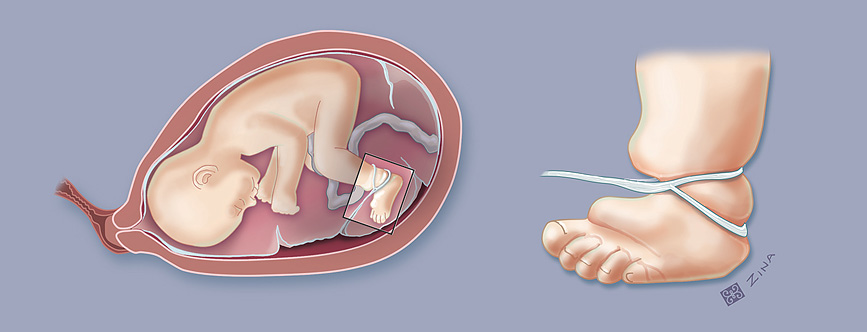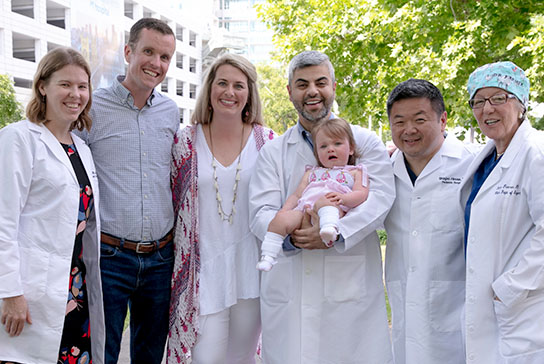Fetal Care and Treatment Center
Amniotic band syndrome

What is amniotic band syndrome?
Amnion is a thin, protective membrane that surrounds the baby in the uterus. If it ruptures, typically early in pregnancy, fibrous strands of amnion can end up floating in the amniotic sac. These string-like bands can attach to the baby’s developing body parts and cause injury. Untreated, the bands become tighter around the body part to which they are attached, which is why amniotic band syndrome often leads to amputation, limb deformity, webbed toes or fingers or defects of the head, face or spine.
Diagnosis
Amniotic band syndrome is typically diagnosed at or soon after birth, based on characteristic physical findings, including ring-like constrictions or amputation defects of the arms, legs, fingers or toes.
In some cases, the condition may be suspected before birth, based on results of specialized screenings such as fetal ultrasonography and amniocentesis. During an ultrasound examination, images can reveal signs of amniotic band syndrome. With amniocentesis, a needle is introduced into the amniotic sac and a sample of fluid is removed to check for alpha fetoprotein, a protein that the fetus produces. Raised levels of the protein may be associated with a number of abnormalities in a developing fetus, including amniotic band syndrome.
Treatment
If the amniotic band is touching an area of the fetus but not causing injury or cutting off blood flow, no surgery is necessary.
Minimally invasive fetal surgery can be an option if the amniotic band is threatening the baby’s life by impeding blood flow to a limb, entangling the umbilical cord, or threatening to cause a severe deforming or facial problem.
In fetoscopic or fetal image-guided surgery, only a small incision is needed to manipulate surgical instruments. The surgeon inserts a tiny scope in the mother’s uterus and uses instruments or laser energy to cut the amniotic band, using a combination of endoscopy and ultrasound to view the fetus. This procedure can immediately reduce the pressure on the affected extremity and allows it to develop normally, without any further damage. In severe cases, fetal surgery may be the best option.
Outcome
Every case of amniotic band syndrome is unique. Babies can typically be treated after birth by a reconstructive surgeon to repair any remaining physical abnormalities. In some cases, surgery prior to birth is possible.
Babies with amniotic band syndrome tend to do well, although limb function may be affected depending on the severity of the defect. Children are monitored throughout development for any problems associated with the disorder.
Contact us or make a referral
Physicians, patients and families can contact the Fetal Care and Treatment Center to find out more about our fetal care services.
Wondering about what types of conditions should be referred to us? View list of conditions to refer.
Referring physicians from other facilities, please use our Fetal Care and Treatment Center Referral form to refer patients and request services.
UC Davis Children’s Hospital
4301 X Street, 1st Floor, Suite 1501
Sacramento, CA 95817
The Fetal Care and Treatment Center is located within UC Davis Children’s Hospital.
View map and directionsarrow_forward

